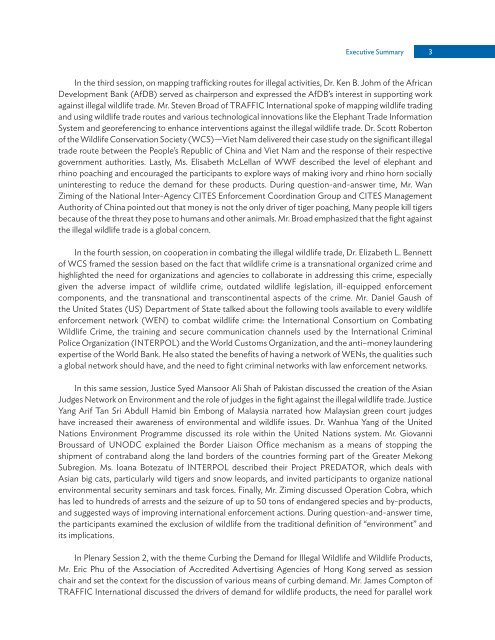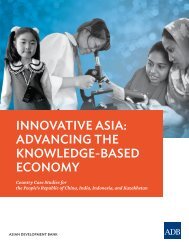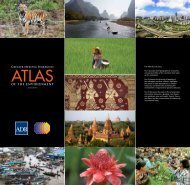ETEE7
ETEE7
ETEE7
Create successful ePaper yourself
Turn your PDF publications into a flip-book with our unique Google optimized e-Paper software.
Executive Summary 3<br />
In the third session, on mapping trafficking routes for illegal activities, Dr. Ken B. Johm of the African<br />
Development Bank (AfDB) served as chairperson and expressed the AfDB’s interest in supporting work<br />
against illegal wildlife trade. Mr. Steven Broad of TRAFFIC International spoke of mapping wildlife trading<br />
and using wildlife trade routes and various technological innovations like the Elephant Trade Information<br />
System and georeferencing to enhance interventions against the illegal wildlife trade. Dr. Scott Roberton<br />
of the Wildlife Conservation Society (WCS)—Viet Nam delivered their case study on the significant illegal<br />
trade route between the People’s Republic of China and Viet Nam and the response of their respective<br />
government authorities. Lastly, Ms. Elisabeth McLellan of WWF described the level of elephant and<br />
rhino poaching and encouraged the participants to explore ways of making ivory and rhino horn socially<br />
uninteresting to reduce the demand for these products. During question-and-answer time, Mr. Wan<br />
Ziming of the National Inter-Agency CITES Enforcement Coordination Group and CITES Management<br />
Authority of China pointed out that money is not the only driver of tiger poaching, Many people kill tigers<br />
because of the threat they pose to humans and other animals. Mr. Broad emphasized that the fight against<br />
the illegal wildlife trade is a global concern.<br />
In the fourth session, on cooperation in combating the illegal wildlife trade, Dr. Elizabeth L. Bennett<br />
of WCS framed the session based on the fact that wildlife crime is a transnational organized crime and<br />
highlighted the need for organizations and agencies to collaborate in addressing this crime, especially<br />
given the adverse impact of wildlife crime, outdated wildlife legislation, ill-equipped enforcement<br />
components, and the transnational and transcontinental aspects of the crime. Mr. Daniel Gaush of<br />
the United States (US) Department of State talked about the following tools available to every wildlife<br />
enforcement network (WEN) to combat wildlife crime: the International Consortium on Combating<br />
Wildlife Crime, the training and secure communication channels used by the International Criminal<br />
Police Organization (INTERPOL) and the World Customs Organization, and the anti–money laundering<br />
expertise of the World Bank. He also stated the benefits of having a network of WENs, the qualities such<br />
a global network should have, and the need to fight criminal networks with law enforcement networks.<br />
In this same session, Justice Syed Mansoor Ali Shah of Pakistan discussed the creation of the Asian<br />
Judges Network on Environment and the role of judges in the fight against the illegal wildlife trade. Justice<br />
Yang Arif Tan Sri Abdull Hamid bin Embong of Malaysia narrated how Malaysian green court judges<br />
have increased their awareness of environmental and wildlife issues. Dr. Wanhua Yang of the United<br />
Nations Environment Programme discussed its role within the United Nations system. Mr. Giovanni<br />
Broussard of UNODC explained the Border Liaison Office mechanism as a means of stopping the<br />
shipment of contraband along the land borders of the countries forming part of the Greater Mekong<br />
Subregion. Ms. Ioana Botezatu of INTERPOL described their Project PREDATOR, which deals with<br />
Asian big cats, particularly wild tigers and snow leopards, and invited participants to organize national<br />
environmental security seminars and task forces. Finally, Mr. Ziming discussed Operation Cobra, which<br />
has led to hundreds of arrests and the seizure of up to 50 tons of endangered species and by-products,<br />
and suggested ways of improving international enforcement actions. During question-and-answer time,<br />
the participants examined the exclusion of wildlife from the traditional definition of “environment” and<br />
its implications.<br />
In Plenary Session 2, with the theme Curbing the Demand for Illegal Wildlife and Wildlife Products,<br />
Mr. Eric Phu of the Association of Accredited Advertising Agencies of Hong Kong served as session<br />
chair and set the context for the discussion of various means of curbing demand. Mr. James Compton of<br />
TRAFFIC International discussed the drivers of demand for wildlife products, the need for parallel work





